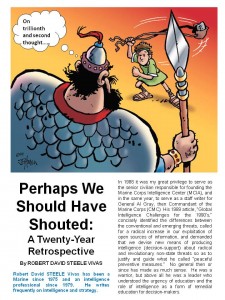
Although there are important elements I disagree with — in some cases strenuously — US Army Colonel Douglas Macgregor (Ret.) has written an important piece on the fundamental changes and massive budget reductions that are needed to improve America's ability to survive into the future.
Macgregor gets the three essentials right, I believe:
1) the threat America faces is now massively reduced; its future character may very well not be what conventional wisdom expects, and Americans need to fundamentally change how we interact with the rest of the world,
2) before any changes are effected in the size, character and funding of our armed forces, a comprehensive audit must be successfully and immediately completed to understand how we spend our money, and funding should be withheld unless and until that is done, and
3) massive changes are needed in our armed forces and their leadership, organization, staffing, weapons, and more.
Macgregor's two part article, “Lean Mean Fighting Machine” and “A Radical Plan for Cutting the Defense Budget and Reconfiguring the Military.” Both are published by Foreign Policy; I believe they merit your thorough reading and consideration.
Phi Beta Iota: The US Marine Corps understood all this in 1989, and sought to change the defense paradigm from worst case to most likely in 1992; then Secretary of Defense Dick Cheney and his subordinates were not at all interested. Right-sizing defense–and the whole of government–is not that difficult, provided that one has absolute integrity rooted in real-world truthful intelligence. That cannot be said of the US Government today.
See Also:
2010: Human Intelligence (HUMINT) Trilogy Updated
2009 Perhaps We Should Have Shouted: A Twenty-Year Restrospective
2008 U.S. Naval Power in the 21st Century
2001 Threats, Strategy, and Force Structure: An Alternative Paradigm for National Security
2000 Presidential Leadership and National Security Policy Making
1998 JFQ The Asymmetric Threat: Listening to the Debate
1995 GIQ 13/2 Creating a Smart Nation: Strategy, Policy, Intelligence, and Information
1993 On Defense & Intelligence–The Grand Vision
1992 MCU Thinking About Revolution
1992 E3i: Ethics, Ecology, Evolution, & intelligence (An Alternative Paradigm)







